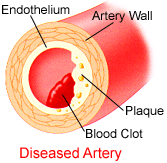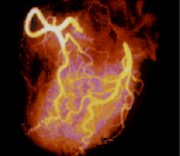Related terms: MI, myocardial infarction, AMI, acute myocardial infarction, STEMI, N-STEMI
|
Heart Attack Facts

|
|
|
|
Think you're having a heart attack? Call 9-1-1.
|
About 735,000 Americans have heart attacks every year. In fact, it is estimated that about every 34 seconds, somebody in the United States has a heart attack. For people who get to a hospital quickly, advances in treatments have helped lower the number of deaths from heart attack. Today, those who recover from a heart attack are more likely to achieve an improved state of health than ever before.
What causes a heart attack?
A heart attack is also called a myocardial infarction (MI) or an acute myocardial infarction (AMI). Many heart attacks are caused by a complete blockage of a vessel in your heart, called a coronary artery. A blocked coronary artery prevents oxygen-rich blood and nutrients from reaching a section of the heart. If blood cannot reach the heart muscle, it will die. By getting medical treatment quickly, you can reduce this damage, but once a section of heart muscle dies, the damage lasts forever.
Heart attacks may be caused by
 A fatty buildup called plaque, which severely narrows or blocks a coronary artery. The blockage shuts off all blood flow to the section of heart muscle fed by the artery.
A fatty buildup called plaque, which severely narrows or blocks a coronary artery. The blockage shuts off all blood flow to the section of heart muscle fed by the artery.
- A blood clot, which can block an artery already narrowed by plaque. The blood clot may come from another part of the body, carried by blood flow through the narrowed artery.
- A clot that forms at the site of "soft" plaque on the inside of the artery. This plaque, which has a thin covering over it, is called vulnerable plaque. When vulnerable plaque ruptures, it can cause a blood clot to form, blocking the artery.
- A condition called coronary artery spasm, which involves a coronary artery going into spasm and narrowing. Because of this narrowing, less or no blood can reach parts of the heart muscle. It can happen in arteries with or without signs of plaque buildup.
Heart attacks are divided into 2 types, by their severity. The more severe type of heart attack is called an ST-segment-elevation myocardial infarction, or STEMI. In a STEMI, the coronary artery is completely blocked by a blood clot, so all of the heart muscle that usually receives blood from the affected artery will begin to die.
Doctors can tell if you are having a STEMI because of the characteristic changes that show on an electrocardiogram (ECG). One of those changes is an elevation in the ST segment. This elevation indicates that a large amount of the heart muscle is being damaged. The elevated ST segment is how this type of heart attack got its name.
A non-ST-segment-elevation myocardial infarction, or NSTEMI, means that the coronary artery is only partly blocked, so only part of the heart muscle being supplied by the affected artery may be damaged. An NSTEMI does not produce the ST segment elevation on an ECG. This can sometimes make it hard for doctors to determine if a patient is having a heart attack or an episode of angina.
See also on this site:
What are the symptoms?
A heart attack may signal its onset with sudden, powerful chest pain that patients often say feels like a crushing or squeezing sensation or a very heavy weight on their chest. The pain may move to the arm, jaw, shoulder, back, or neck. Other symptoms may include an unexplained shortness of breath, lightheadedness, dizziness, fainting, sweating, or a sick stomach.
Not everyone will have the classic symptoms. For some people, a heart attack feels like a burning sensation, similar to indigestion or heartburn, and the pain may be in only a small area of the chest. Some people may not feel anything at all.
Heart attack symptoms in women are often different from those experienced by men. Many women who have a heart attack do not know it. Women tend to feel a burning sensation in their upper abdomen and may experience lightheadedness, an upset stomach, and sweating. Because they may not feel the typical pain in the left half of their chest, many women may ignore symptoms that indicate they are having a heart attack.
See a doctor right away if you have any unusual chest pain (more severe than typical angina) that lasts 5 minutes or longer. If you are having a heart attack, saving heart muscle turns into a race against time.
See also on this site: Heart Attack Warning Signs
How is a heart attack diagnosed?
In addition to talking with you and checking your heart rate and blood pressure, emergency room staff will usually do the following tests.
- An electrocardiogram (ECG or EKG) to find out which of your coronary arteries is blocked and to monitor your heart rhythm.
- A blood test, which can help determine how much damage there is by finding certain enzymes that have leaked from your damaged heart muscle cells into your bloodstream. Doctors usually look for enzymes called creatine kinase myocardial band (CK-MB), myoglobin, and cardiac troponin T and I, which are released when the heart muscle is damaged. Doctors may also look for fibrinogen and C-reactive protein (CRP) in the bloodstream.
- A chest x-ray to see if your heart is enlarged or if your lungs are filled with fluid.
After your condition has stabilized, doctors may order more tests to find out how damaged your heart is.
- A thallium stress test, also called a nuclear stress test, uses a radioactive substance that is injected into your bloodstream to show how blood flows through your arteries. Doctors can see if parts of the heart muscle are damaged or dead, or if you have a serious narrowing in an artery.
- Echocardiography, which lets doctors see if there is damage to the heart muscle by watching the motion of the lower-left chamber (the left ventricle). One measurement that is usually taken at this time is your heart's left ventricular ejection fraction, or LVEF. During the heartbeat's two-part pumping action, the heart contracts and relaxes. When the heart contracts, it pumps (or ejects) blood out of the ventricles. When the heart relaxes, the ventricles fill up with blood. No matter how strongly your heart contracts, it never ejects all of the blood out of its ventricles. The LVEF refers to the percentage of blood that is pumped out of the left ventricle with each heartbeat. The LVEF for a healthy heart is between 55% and 70%. Your LVEF may be lower if your heart muscle has been damaged by the heart attack. Echocardiography is also used to see if there is decreased heart wall motion (called hypokinesia or hypokinesis).
- Coronary angiography, which is performed in the cardiac catheterization laboratory with mild sedation. Dye is injected into your bloodstream to give doctors an x-ray "movie" of heart action and blood flow through your valves and arteries (called an angiogram). Doctors can see the number of blockages that you have and how serious those blockages are. Doctors often use this test to find out which treatment option may be best for you.
Heart attack outcomes
The outcome of a heart attack depends on several factors:
- Where the coronary blockage happens. Blockages on the left side of your heart are usually more dangerous.
- Whether rhythm is disturbed. If the blockage also causes an irregular heartbeat called an arrhythmia, it may cause sudden death. Either fast beating called tachycardia or rapid, uncoordinated contractions called ventricular fibrillation may happen. Ventricular fibrillation prevents blood flow, which must be quickly restored through cardiopulmonary resuscitation (CPR) or electrical therapy (defibrillation).
- Whether your heart is supplied by another blood source. Sometimes a person's body responds to a gradual blocking of an artery by widening another vessel that supplies blood to that same part of the heart. This makes what is called a collateral blood source. If this is the case, you will have less severe damage from the major blockage.
- How soon you got help. In most cases, getting medical attention within an hour of the start of your attack reduces the amount of heart muscle you lose.
What treatments are available?
The goals of heart attack treatment are to return blood flow to your heart muscle, bring back a regular heartbeat, and give your heart time to recover.
The development of "clot busters" called thrombolytic agents (streptokinase, urokinase, tissue plasminogen activator) has increased survival rates for heart attack patients when these medicines are given as soon as possible after an attack. The term thrombolysis means to break up a clot, and that is exactly what these medicines do. In some cases, these medicines can break up a clot within minutes. To work best, they must be given as soon as possible after a heart attack.
Most patients respond well to thrombolytic agents. But, if patients are at a facility with a cardiac catheterization laboratory (cath lab), they may not be given clot busters and instead may be taken right away to the cath lab where techniques such as balloon angioplasty and stenting are used to open the vessel. Patients who do not respond to these interventions may then need further emergency care, such as coronary artery bypass surgery or a related procedure.
Heart attack patients may also receive antiplatelet therapy, including aspirin, and blood-thinning medicines (anticoagulants) to stop clots from forming or growing in size. Also, oxygen may be given to increase the amount of oxygen in the blood still flowing through your heart. Painkillers may be used to reduce the pain. Some patients are also given medicines aimed at slowing their heart rate, opening and relaxing their blood vessels, and reducing the work of the heart.
Rest is important very early after a heart attack. But within a few days, you should be up and moving around, taking short walks, and getting other kinds of limited exercise. Studies have shown that the heart benefits from exercise, even after a heart attack.
Left Ventricular Aneurysms
Sometimes after a heart attack, an aneurysm forms in the heart's main pumping chamber, called the left ventricle. If a section of the heart wall becomes damaged after a heart attack, it causes scarring and the heart wall grows thinner and weaker. This may cause a ventricular aneurysm to form. The weakened area of aneurysm does not work well, which makes your heart work harder to pump blood to the rest of your body. Ventricular aneurysms may cause shortness of breath, chest pain, or an irregular heart beat (arrhythmia). If a ventricular aneurysm leads to congestive heart failure, left ventricular heart failure, or arrhythmia, your doctor may want you to have surgery.
See also on this site: Recovering From a Heart Attack
"Research shows flu can trigger heart attack"
See on other sites:
MedlinePlus
https://medlineplus.gov/heartattack.html
Heart Attack
American Heart Association
www.heart.org/HEARTORG/Conditions/HeartAttack/Heart-Attack_UCM_001092_SubHomePage.jsp
Heart Attack
Updated August 2016



